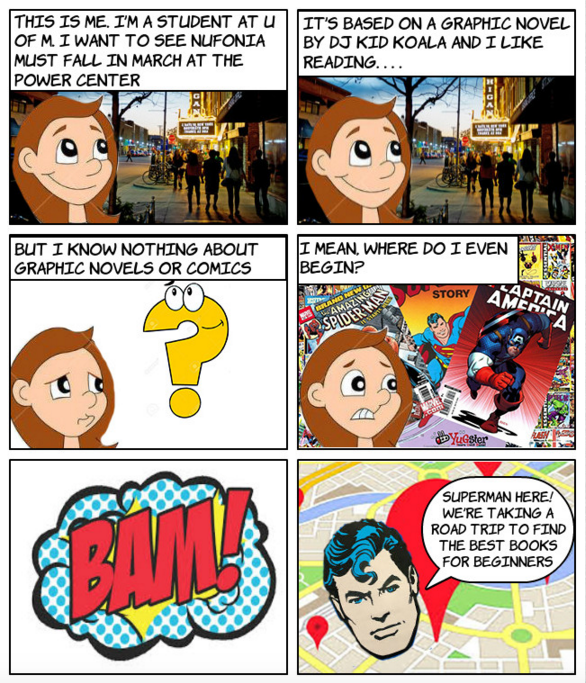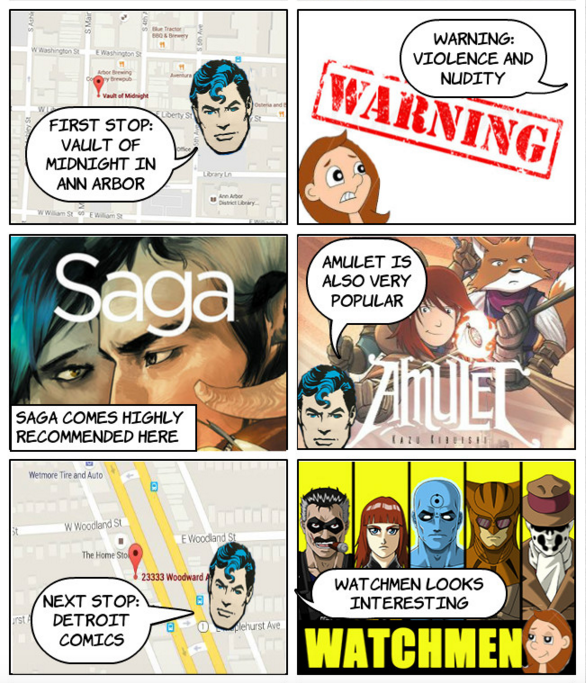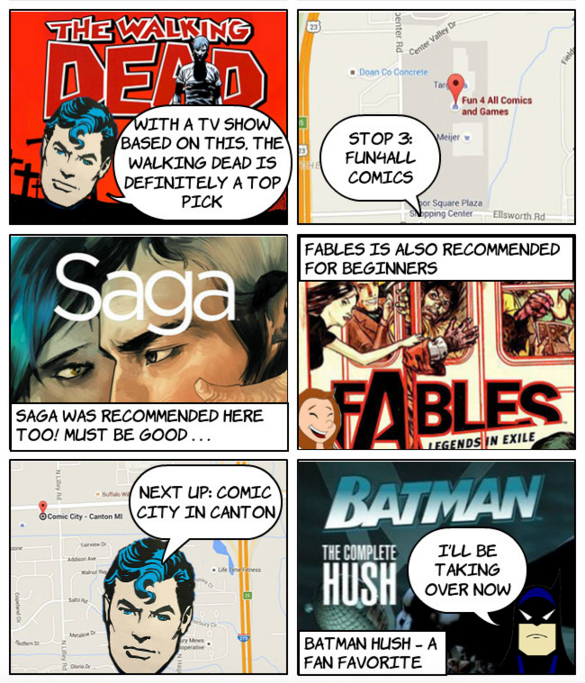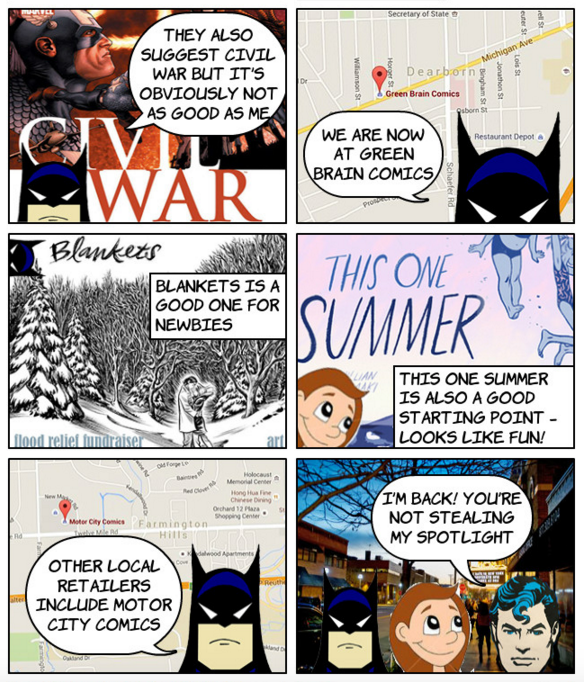Robots at the Power Center

Before Nufonia Must Fall this past weekend, U-M Robotics showed off their own robots in the lobby of Power Center.
Contest: Show us your robot dance to win Nufonia tickets!
On March 11-12, 2016, DJ Kid Koala’s graphic novel Nufonia Must Fall will come to life on stage at the Power Center in Ann Arbor. This live adaptation unfolds via real-time filming of more than a dozen miniature stages and a cast of puppets, while Kid Koala and the Cecilia Quartet provide original live scoring on piano, strings, and turntables.
Win tickets by showing us your robot dance moves!
What: A contest of robot dances. Three winners will receive a pair of tickets to see Nufonia Must Fall. The first place winner also receives goodies from our friends at Green Brain Comics!
How to enter: Create a robot dance video to the music in the above contest video. Upload your video and share the link with us via the comments below, Facebook, Twitter, or Instagram.
- On Facebook, enter by posting your video on our wall. Be sure to include “robot dance contest” in your video description.
- On Twitter, enter by tweeting your video @UMSNews. Be sure to include “robot dance contest” in your tweet.
- On Instagram, tag @UMSNews in your video. Be sure to include “robot dance contest” in your post description.
- Post a link to your video in the comments below. Be sure to include “robot dance contest” in your post description.
Contest timeline: Tuesday, March 1 at 9 am to Wednesday, March 9 at 5 pm.
Winners announced: Morning of Thursday, March 10.
Questions? Ask them in the comments below.
Nufonia Must Fall: A Guide to Graphic Novels

Nufonia Must Fall, on stage. Photo by Jorn Mulder.
On March 11-12, 2016, DJ Kid Koala’s graphic novel Nufonia Must Fall will come to life on stage at the Power Center in Ann Arbor. This live adaptation unfolds via real-time filming of more than a dozen miniature stages and a cast of puppets, while Kid Koala and the Cecilia Quartet provide original live scoring on piano, strings, and turntables.
I’m a newbie to the graphic novel genre, but I had heard about the active comic scene around town. So, I reached out to the experts, our local comic book stores, for recommendations of the best graphic novels or comics for beginners.
Thank you to our local retailers: Vault of Midnight, Detroit Comics, Fun4All Comics & Games, Comic City in Canton, Green Brain Comics, and Motor City Comics, for participating.
What you should read first, according to our local comic book experts:
This comic strip was created using Chogger.
Nufonia Must Fall is at Power Center March 11-12, 2016.
Study Up: Brief History of Robots in Film
 Photo: Nufonia Must Fall, on stage. By Jorn Mulder.
Photo: Nufonia Must Fall, on stage. By Jorn Mulder.
DJ Kid Koala’s graphic novel Nufonia Must Fall is about a headphones-sporting robot on the verge of obsolescence who falls in love with a lonely office girl. On March 11-12, 2016, the live adaptation of this novel comes to Power Center. The show will feature real-time filming of more than a dozen miniature stages and a cast of puppets, while Kid Koala and the Cecilia Quartet provide original live scoring on piano, strings, and turntables.
This won’t be the first time a robot appears on the film screen. We present to you, a brief history of robots in film.
1930-1940
The Wizard of Oz (1939) introduced the Tin Man, one of film’s most recognizable robots. While the Tin Man is lovable and human-like, the 30’s and 40’s still frequently included narratives of mad scientists and uncontrollable killer robots.
1950-1960
Film robots of the 1950’s reflected fear of the new forms of violence made possible by technology during the Cold War. The Day the Earth Stood Still (1951) depicts Gort, an enormous, metal, alien robot who delivers an anti-nuclear message to Earth. Stanley Kubrick’s 2001: A Space Odyssey (1968) features HAL, one of film’s most recognizable robots. HAL is a computer, not a traditional corporeal robot, and the film predicts robots with advanced speech comprehension and processing abilities.
1970-1980
Star Wars set the standard for robots on film in the 1970’s and 80’s. C-3PO and R2-D2, two of the series’ most lovable and iconic characters, are motivated by human emotions and experiences. But the period also produced many evil robots, notably the Terminator franchise, which portrays wars between humans and robots.
1990-2000 and beyond
Robots in the movies at the turn of the 21st century affirm the increasing affection for technology of the time. WALL-E (2004) reverses the trope of robot domination when a pair of robots saves the earth for humanity.
For additional information about the history of robots in cinema visit this website.
Excerpted from UMS Learning Guide about Nufonia Must Fall.
Nufonia Must Fall is at Power Center in Ann Arbor March 11-12, 2016.
Explore: Connections Between UMS and U-M Museum of Art
Visual and performing arts have a close relationship. We asked our partners and friends at UMMA (U-M Museum of Art) to link performances on the UMS season with visual art works that are part of the museum’s permanent collection.
Related performance: Tanya Tagaq in concert with Nanook of the North
February 6, 2016
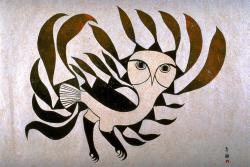 Artwork: Kenojuak Ashevak (Canadian, 1927-2013). Sun Owl, 1963. Stonecut print on paper. Gift of Mr. and Mrs. Eugene B. Power, 1964/2.103
Artwork: Kenojuak Ashevak (Canadian, 1927-2013). Sun Owl, 1963. Stonecut print on paper. Gift of Mr. and Mrs. Eugene B. Power, 1964/2.103
Like Tanya Tagaq, Kenojuak Ashevak was from Nunavut and her art was inspired by her Inuit experience. She often depicted animals from the Arctic such as this owl, but, also like Tagaq, she relies on her creativity and imagination. Ashevak explained that she drew as she thought, and so she produced spontaneous and improvisatory images.
Related performance: Camille A. Brown & Dancers: Black Girl — A Linguistic Play
February 13, 2016
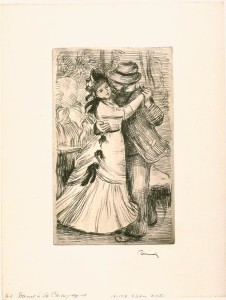 Artwork: Pierre Auguste Renoir (French, 1841-1919). Dance in the Country, c. 1890
Artwork: Pierre Auguste Renoir (French, 1841-1919). Dance in the Country, c. 1890
Soft-ground etching on paper. Museum Purchase, 1959/1.102
In Renoir’s beloved image of country dance we see an earlier century’s ritual of recreation. Although more restrained than contemporary dance, it represents social dance, one of the inspirations for choreographer Camille Brown’s work.
Related performance: Nufonia Must Fall
March 11-12, 2016
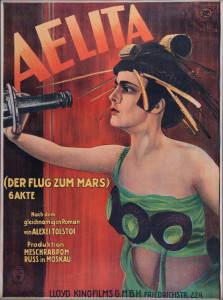 Artwork: P. Grasnick (n.d.). Aelita, 1924
Artwork: P. Grasnick (n.d.). Aelita, 1924
Lithograph on buff woven paper, laid down on canvas. Gift of James T. Van Loo, 2013/2.233
This poster is for the movie Aelita, which is often called the first Soviet science fiction film, created during the sometimes hope-filled beginnings of the Soviet Union. A mysterious radio message is beamed around the world, and among the engineers who receive it are Los, the hero of the film. Aelita is the daughter of Tuskub, the ruler of a totalitarian state on Mars. With a telescope, Aelita is able to watch Los who obsesses about being watched by her. He builds a spaceship and travels to Mars where he is thrown in prison, begins a proletarian uprising and experiences the confusion of reality and fantasy. While Nufonia Must Fall is no sci-fi film, it is based on a graphic novel of the same title, and viewers might find similarities between the genres.
Related performance: Gil Shaham Bach Six Solos
with original films by David Michalek
March 26, 2016
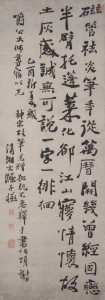 Artwork: Shitao (Shih-t’ao; Chinese, 1642-1707) Ode on a Wanli-era Imperial Brush Ink on paper, 1705. Museum purchase made possible by the Margaret Watson Parker Art Collection Fund, 1965/2.75.
Artwork: Shitao (Shih-t’ao; Chinese, 1642-1707) Ode on a Wanli-era Imperial Brush Ink on paper, 1705. Museum purchase made possible by the Margaret Watson Parker Art Collection Fund, 1965/2.75.
Taking an honored and beloved corpus of music from the past, Gil Shaham transforms its familiar beauty into a fresh, contemporary work of art. Similarly, Shitao receives a beautiful gift, a porcelain-handled calligraphy brush, from an earlier generation and uses it to write a poem and create a calligraphic masterpiece. The era and form are new but the inspiration is classic.
Related performance: Mariachi Vargas de Tecalitlán
April 1, 2016
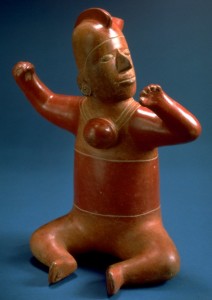 Artwork: Artist Unknown, Mexican, Colima Culture Seated Figure, c. 700 Terracotta Museum purchase made possible by a gift from Helmut Stern, 1983/1.355Artist Unknown, Mexican, Colima CultureSeated Figure, c. 700TerracottaMuseum purchase made possible by a gift from Helmut Stern, 1983/1.355
Artwork: Artist Unknown, Mexican, Colima Culture Seated Figure, c. 700 Terracotta Museum purchase made possible by a gift from Helmut Stern, 1983/1.355Artist Unknown, Mexican, Colima CultureSeated Figure, c. 700TerracottaMuseum purchase made possible by a gift from Helmut Stern, 1983/1.355
This lovely terracotta seated figure is an example of the native arts and culture celebrated by Mexican visual and musical artists. Mariachi Vargas de Tecalitlán transform a regional folk music into a world-class art form.
Related performance: Zafir: Musical Winds from North Africa to Andalucia
April 15, 2016
 Artwork: Artist Unknown, North Africa Qur’an manuscript leaf in Maghribi script, 13th century Ink, red ochre, paper Museum Purchase, 1959/1.146
Artwork: Artist Unknown, North Africa Qur’an manuscript leaf in Maghribi script, 13th century Ink, red ochre, paper Museum Purchase, 1959/1.146
For Muslims, Arabic script, representing the language of the Qur’an, is a thing of sublime beauty. This page is written in a script called Maghribi, a variation of the earlier, angular, Kufic script. Maghribi features sweeping curves that loop across the page and was developed in North Africa and Spain. This Qur’an page combines traditions of the Middle East, Spain and North Africa as does the music of Simon Shaheen and Zafir.
Interested in more? Visit the U-M Museum of Art today.


